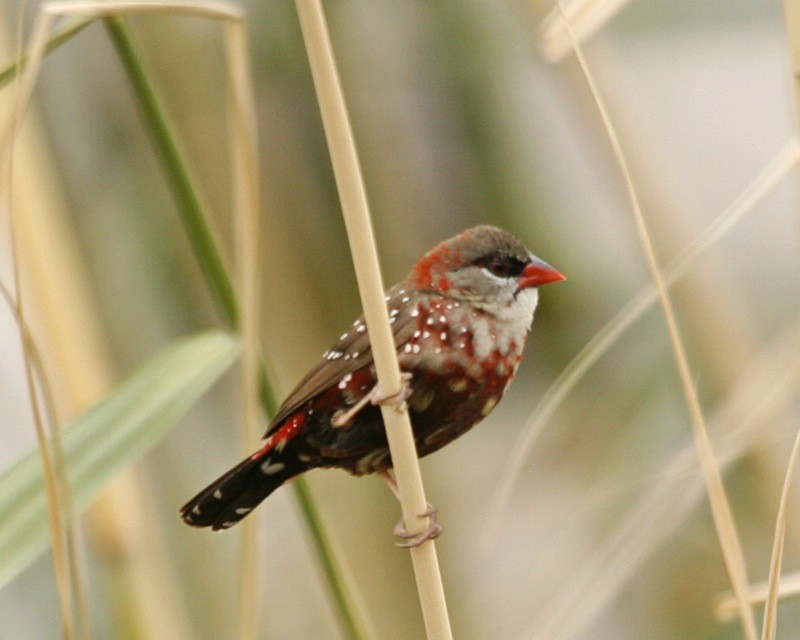Red Avadavat
A species of Avadavats Scientific name : Amandava amandava Genus : Avadavats
Red Avadavat, A species of Avadavats
Botanical name: Amandava amandava
Genus: Avadavats
Content
Description General Info
 Photo By Lip Kee , used under CC-BY-SA-2.0 /Cropped and compressed from original
Photo By Lip Kee , used under CC-BY-SA-2.0 /Cropped and compressed from original Description
This small finch is easily identified by the rounded black tail and the bill that is seasonally red. The rump is red and the breeding male is red on most of the upper parts except for a black eye-stripe, lower belly and wings. There are white spots on the red body and wing feathers. The non-breeding male is duller but has the red-rump while the female is duller with less of the white spotting on the feathers. 
Size
10-10 cm (3.75-4 in)
Colors
Black
Red
Bronze
Gray
White
Life Expectancy
8-17 years
Nest Placement
Shrub
Feeding Habits
Red Avadavat primarily consume grass seeds, supplemented with insects like termites, showcasing opportunistic feeding habits.
Habitat
Red Avadavat typically inhabit grasslands, including damp grassy areas, reeds, and cultivated fields such as rice and sugar-cane fields. They are often found near water sources, such as wetlands along rivers and canals, and prefer lowland areas. Their habitat also includes tamarisk scrub and grassy clearings adjacent to human settlements. Red Avadavat are usually seen at altitudes below 300 m but can occur up to 2100 m in some regions, adapting to various elevations across their broad geographical range.
Dite type
Granivorous
General Info
Feeding Habits
Bird food type
Behavior
This finch is usually seen in small flocks, flying with rapid wingbeats and descending into grass clumps where they are hard to observe. Pairs stay together during the breeding season. These birds produce a distinctive low single note pseep call that is often given in flight. The song is a series of low notes. Birds of a flock will preen each other, ruffling their head feathers in invitation. They feed mainly on grass seeds but will also take insects such as termites when they are available. They build a globular nest made of grass blades. The usual clutch is about five or six white eggs. The beak begins to turn red in May and darkens during November and December. The beak then turns rapidly to black in April and the cycle continues. These seasonal cycles are linked to seasonal changes in daylength. Two ectoparasitic species of bird lice (an ischnoceran, Brueelia amandavae, and an amblyceran, Myrsidea amandava) have been identified living on them and a paramyxovirus has been isolated from birds kept in Japan. 
Distribution Area
Red avadavats are found mainly on flat plains, in places with tall grasses or crops, often near water. The species has four named subspecies. The nominate subspecies is called amandava and is found in Bangladesh, India, Nepal and Pakistan; the Burmese form is called flavidiventris (also found in parts of China, Indonesia, Thailand and Vietnam); the population further east in Java is called punicea and in Cambodia, decouxi. Introduced populations exist in several locations worldwide: southern Spain, Brunei, Fiji, Egypt, Malaysia, the United States, Bahrain, Brunei, Egypt, Fiji, Guadeloupe, Iran, Italy, Réunion, Malaysia, Mexico, the Dominican Republic, Martinique, Portugal, Japan, Puerto Rico, Singapore and Hawaii. 
Species Status
Not globally threatened.
Scientific Classification
Phylum
Chordates Class
Birds Order
Perching birds Family
Estrildid finches Genus
Avadavats Species
Red Avadavat